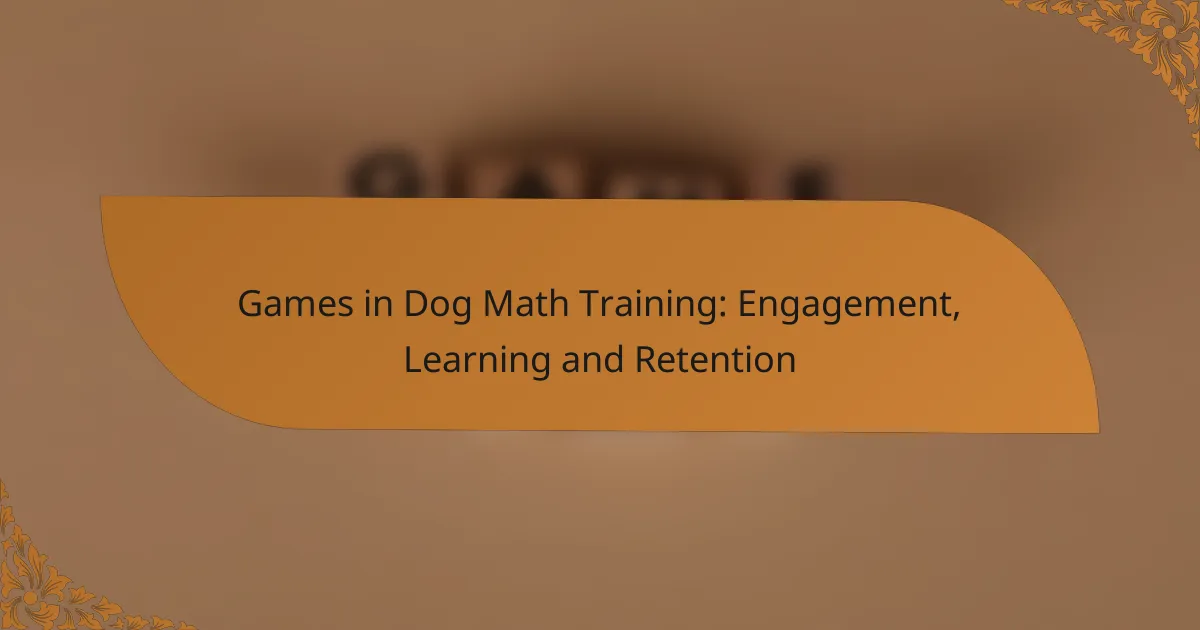Incorporating games into dog math training significantly enhances engagement and retention by transforming the learning experience into an enjoyable and interactive activity. Activities like puzzle toys and agility courses not only stimulate dogs mentally and physically but also reinforce basic math concepts while promoting obedience. By making training fun, both dogs and their owners can benefit from improved learning outcomes.
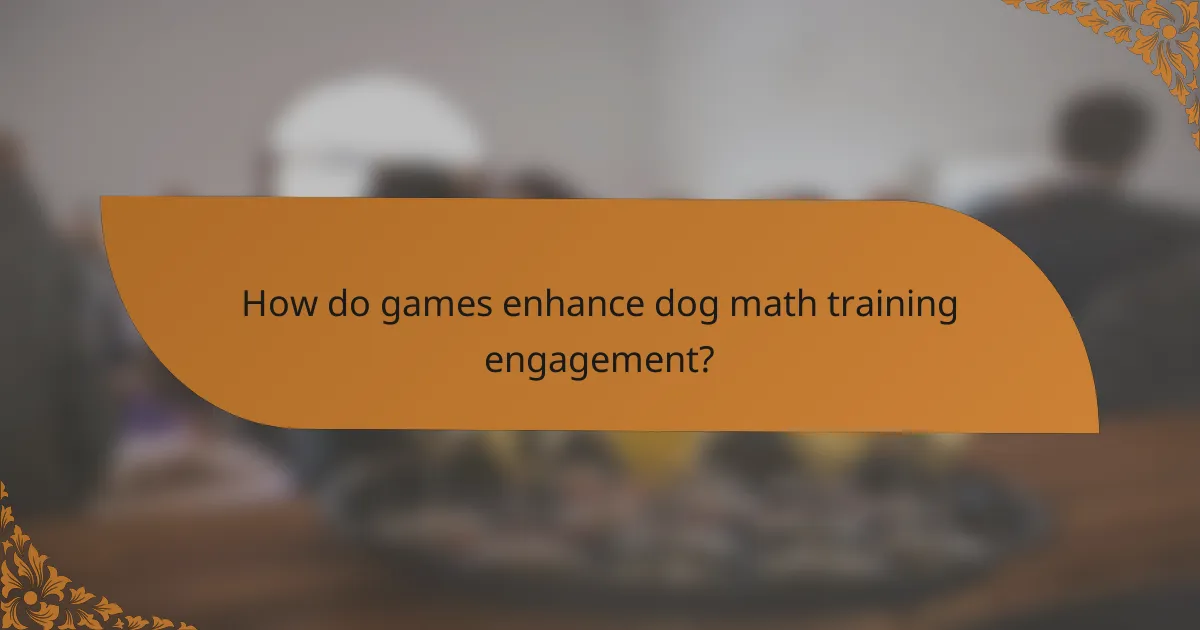
How do games enhance dog math training engagement?
Games significantly boost engagement in dog math training by making the learning process enjoyable and interactive. By incorporating playful elements, dogs are more likely to participate actively and retain the information being taught.
Interactive learning experiences
Interactive games provide hands-on experiences that facilitate learning through play. For instance, using toys that require dogs to solve simple math problems can enhance their understanding while keeping them engaged. Activities like hide-and-seek with treats can also reinforce counting skills as dogs search for hidden rewards.
These interactive experiences cater to different learning styles, allowing dogs to explore concepts at their own pace. Incorporating various game formats can help maintain interest and encourage repeated practice, which is essential for retention.
Increased motivation through rewards
Games often incorporate rewards, which can significantly boost a dog’s motivation to learn math concepts. Positive reinforcement, such as treats or praise, encourages dogs to engage with the training material more enthusiastically. For example, rewarding a dog with a favorite toy after correctly solving a math puzzle can create a positive association with learning.
Setting achievable goals within games, such as completing a series of math challenges, can further enhance motivation. This approach helps dogs feel a sense of accomplishment, making them more likely to participate in future training sessions.
Social interaction benefits
Playing math games can also foster social interaction between dogs and their handlers or other dogs. Engaging in group activities, such as team-based math challenges, promotes camaraderie and can lead to a more enjoyable training environment. This social aspect can enhance the overall learning experience by providing dogs with a sense of belonging.
Additionally, social interactions during games can help reduce anxiety and build confidence in dogs. As they learn to work with others, they become more comfortable with new challenges, which can translate to better retention of math skills over time.
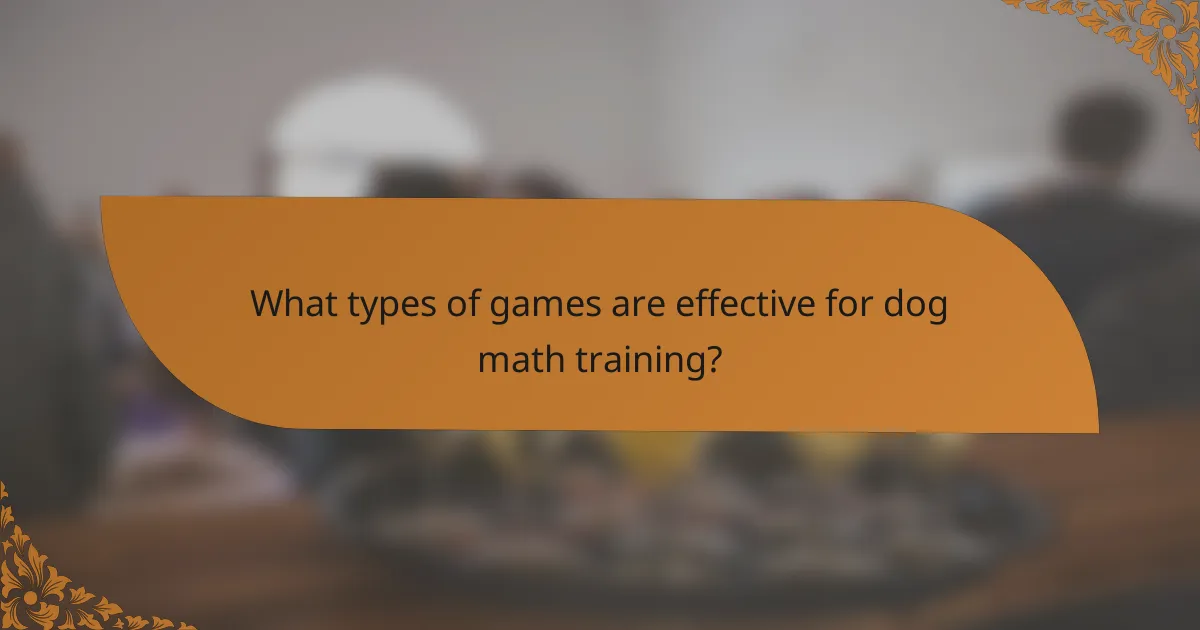
What types of games are effective for dog math training?
Effective games for dog math training include puzzle toys, agility courses, and memory games. These activities engage dogs mentally and physically, enhancing their problem-solving abilities and cognitive skills.
Puzzle toys for problem-solving
Puzzle toys are designed to challenge dogs to think and solve problems to access treats. These toys often require dogs to manipulate parts, push buttons, or slide pieces to reveal rewards. Consider starting with simpler puzzles and gradually increasing the difficulty as your dog becomes more adept.
When selecting puzzle toys, look for those that are durable and safe. Popular options include treat-dispensing balls and interactive games that require multiple steps. Always supervise your dog during play to prevent any ingestion of small parts.
Agility courses for physical engagement
Agility courses combine physical activity with mental challenges, making them excellent for dog math training. These courses typically include obstacles like jumps, tunnels, and weave poles that require dogs to navigate while following commands. Setting up a basic course in your backyard can provide a fun and engaging way to practice.
To enhance learning, incorporate commands that require dogs to count or identify obstacles. For example, ask your dog to jump over a certain number of hurdles or weave through a specific number of poles. This not only boosts physical fitness but also reinforces their understanding of numbers and sequences.
Memory games for cognitive skills
Memory games help improve a dog’s recall and cognitive skills by challenging them to remember the locations of treats or toys. A simple memory game involves hiding treats under cups and encouraging your dog to find them. Start with one or two cups and gradually increase the number as your dog becomes more skilled.
To maximize engagement, use a mix of scents and sounds to keep the game interesting. You can also incorporate commands that require your dog to wait or stay, enhancing their focus and self-control. Regular practice of memory games can significantly boost your dog’s mental agility.

How can dog owners implement math training games?
Dog owners can implement math training games by incorporating simple, engaging activities that teach basic math concepts while reinforcing obedience. These games can enhance learning and retention by making training enjoyable for both the dog and the owner.
Step-by-step game introduction
Start with basic commands and gradually introduce math concepts. For example, use treats to teach addition by rewarding the dog for performing a certain number of tricks. Begin with one or two tricks, then increase the complexity as the dog becomes more comfortable with the game.
Use visual aids, like counting treats or toys, to help the dog understand the concept of numbers. This visual reinforcement can aid in retention and make the learning process more interactive.
Incorporating games into daily routines
Integrate math games into daily walks or playtime to reinforce learning. For instance, ask your dog to perform a trick for every few steps taken, creating a fun way to practice counting. This keeps the training consistent and part of your dog’s everyday life.
Consider setting aside specific times during the day for math training sessions. Short, focused sessions of around 5-10 minutes can be effective, allowing for repetition without overwhelming the dog.
Using technology for interactive training
Leverage apps and online resources designed for dog training that include math games. These tools often provide interactive elements that can engage both the owner and the dog, making learning more dynamic. Look for apps that offer step-by-step guidance and progress tracking.
Additionally, consider using smart toys that respond to your dog’s actions, providing feedback and rewards based on their performance in math-related tasks. This can enhance motivation and make the learning experience more enjoyable.
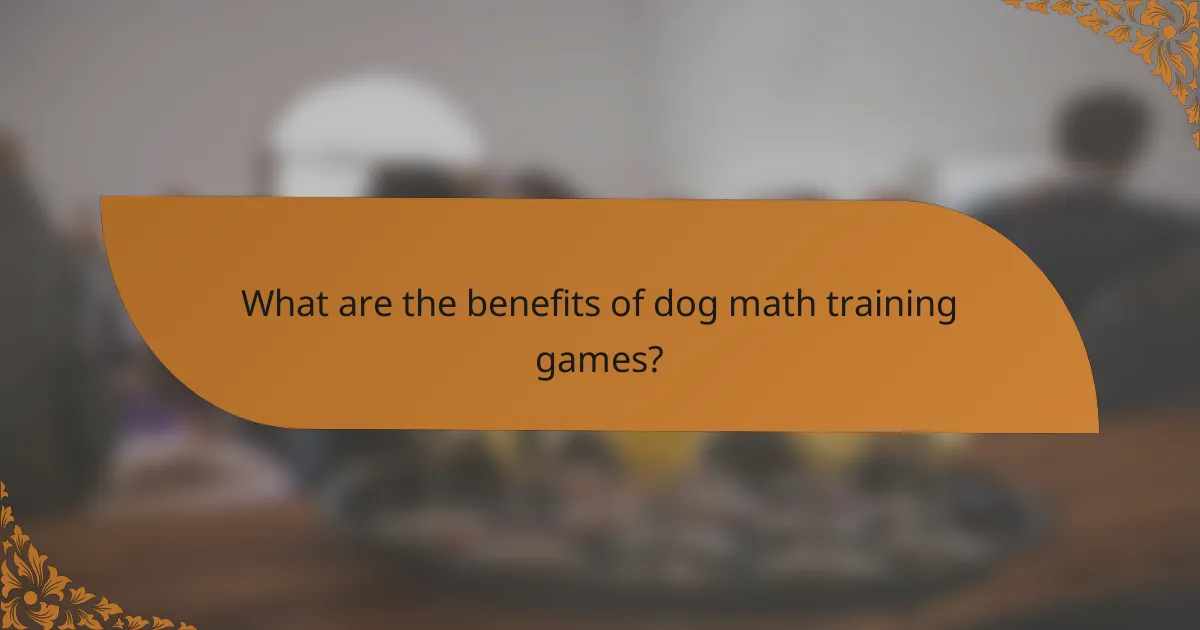
What are the benefits of dog math training games?
Dog math training games offer numerous benefits, including improved cognitive skills, enhanced bonding between owner and dog, and better long-term retention of learned concepts. These games stimulate mental engagement, making learning enjoyable and effective for dogs.
Improved cognitive skills
Engaging in math training games helps dogs develop their cognitive abilities. These activities challenge their problem-solving skills and encourage them to think critically. For instance, games that involve counting treats or solving simple puzzles can significantly enhance a dog’s mental agility.
To maximize cognitive benefits, vary the difficulty of the games. Start with basic tasks and gradually introduce more complex challenges. This progressive approach keeps the dog engaged and promotes continuous learning.
Enhanced owner-dog bonding
Participating in math training games strengthens the bond between the owner and the dog. Shared activities foster trust and communication, making the relationship more rewarding. When dogs see their owners actively involved in their learning, they feel more connected and motivated.
To enhance this bonding experience, incorporate praise and rewards during the games. Positive reinforcement not only boosts the dog’s confidence but also reinforces the owner’s role as a supportive partner in their learning journey.
Long-term retention of learned concepts
Math training games contribute to the long-term retention of concepts by reinforcing learning through repetition and engagement. Dogs are more likely to remember skills practiced in a fun and interactive manner compared to traditional training methods. Regularly revisiting these games helps solidify their understanding.
To ensure effective retention, schedule consistent training sessions. Short, frequent practice sessions are often more beneficial than longer, infrequent ones. Aim for 5 to 10 minutes of focused play several times a week to keep the concepts fresh in your dog’s mind.

What criteria should be considered when choosing math training games?
When selecting math training games for dogs, consider factors such as the dog’s age, learning style, game complexity, and engagement level. These criteria help ensure that the games are effective in promoting learning and retention of math skills.
Dog’s age and learning style
The age of the dog significantly influences its ability to learn through math training games. Younger dogs may benefit from more interactive and stimulating games, while older dogs might prefer simpler tasks that require less physical exertion.
Additionally, each dog has a unique learning style. Some dogs respond better to visual cues, while others may learn more effectively through auditory signals or hands-on interaction. Tailoring the game to match the dog’s preferred learning style can enhance engagement and retention.
Game complexity and engagement level
The complexity of math training games should align with the dog’s current skill level. Games that are too challenging can lead to frustration, while overly simple games may not provide enough stimulation. Aim for a balance where the dog feels challenged but not overwhelmed.
Engagement is crucial for effective learning. Incorporate elements that keep the dog interested, such as rewards, varying tasks, and interactive components. For instance, using treats or toys as incentives can significantly increase a dog’s motivation to participate in math training activities.
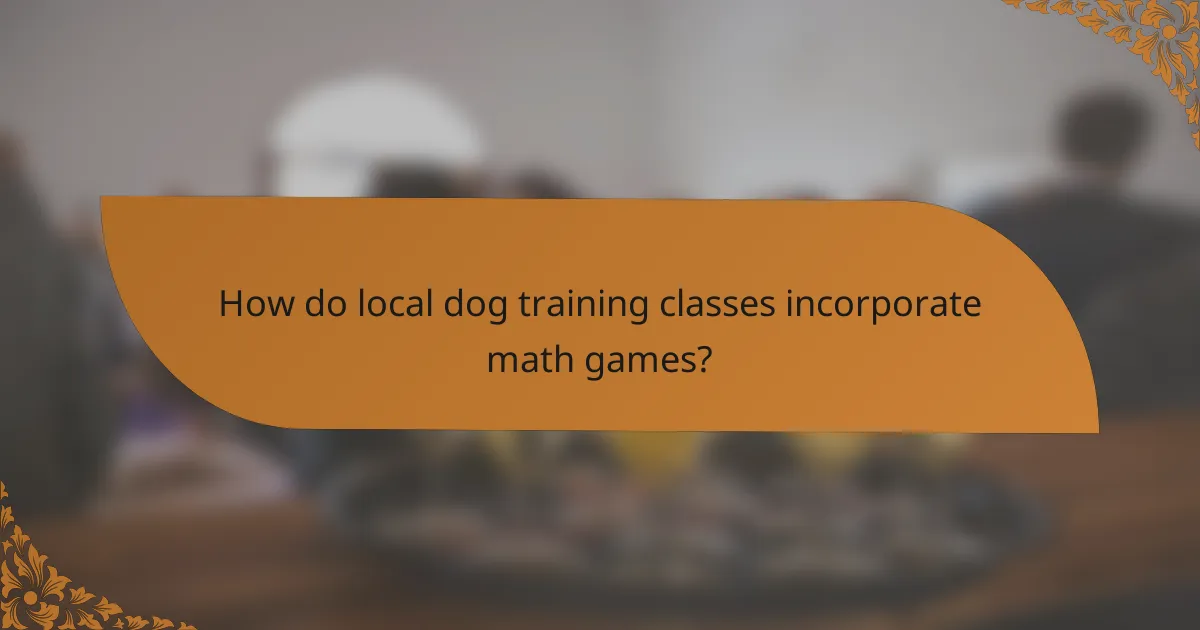
How do local dog training classes incorporate math games?
Local dog training classes often integrate math games to enhance engagement and learning. These games help dogs develop problem-solving skills while reinforcing basic commands and obedience through interactive activities.
Types of math games used in dog training
Common types of math games in dog training include counting exercises, where dogs learn to associate numbers with actions, and puzzle games that require them to solve simple problems to receive a reward. For example, a trainer might use treats to encourage a dog to perform a series of tasks that correspond to a specific number, reinforcing both math concepts and obedience.
Benefits of incorporating math games
Incorporating math games into dog training offers several benefits, including increased mental stimulation and improved retention of commands. Dogs that engage in these activities tend to show better focus and responsiveness, making training sessions more effective. Additionally, these games can strengthen the bond between the dog and the owner through shared learning experiences.
Considerations for local classes
When selecting a local dog training class that incorporates math games, consider the trainer’s experience and the class size. Smaller classes often allow for more personalized attention, which can enhance the learning experience. It’s also essential to ensure that the games are appropriate for your dog’s age and skill level to maintain engagement and avoid frustration.
